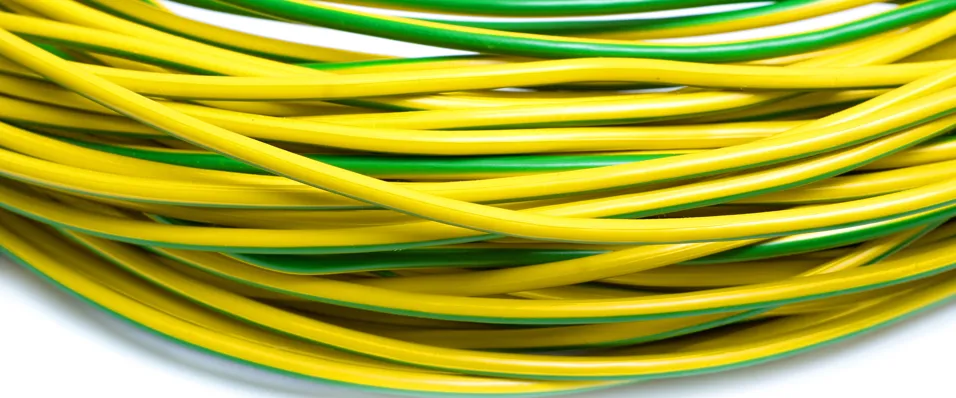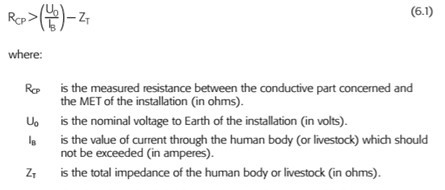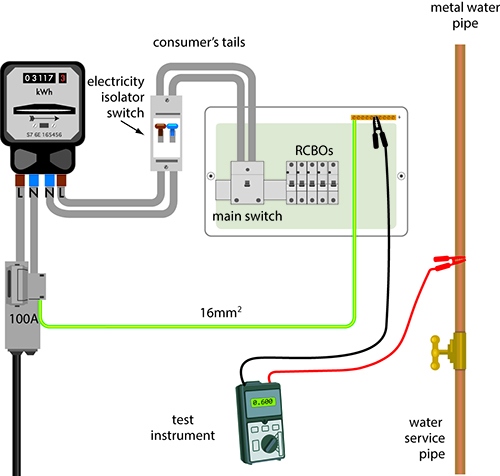
To Bond or not to Bond
What requires protective equipotential bonding?
BS 7671:2018 Regulation 411.3.1.2 requires that;
“In each installation main protective bonding conductors complying with Chapter 54 shall connect to the main earthing terminal extraneous-conductive-parts including the following:
(i) Water installation pipes
(ii) Gas installation pipes
(iii) Other installation pipework and ducting
(iv) Central heating and air conditioning systems
(v) Exposed metallic structural parts of the building.”
Connection of a lightning protection system to the protective equipotential bonding shall be made in accordance with BS EN 62305 and best determined by a lightning protection system designer.
It is important to remember that the above items are only examples of items which may require protective equipotential bonding and it must be verified if these parts actually meet the definition of an extraneous-conductive-part before deciding to connect to the main earthing terminal (MET).
Protective equipotential bonding is different from supplementary bonding. Supplementary bonding is the practice of connecting two conductive simultaneously accessible parts together to reduce the potential difference between the parts.
What is an extraneous conductive part?
The definition of an extraneous-conductive-part as defined within BS 7671:2018 is as follows:
“A conductive part liable to introduce a potential, generally Earth potential, and not forming part of the electrical installation.”
It should be noted that the term extraneous-conductive-part is hyphenated, which means it is a single term which has a specific meaning. It can sometimes be difficult to determine if a part meets this requirement, therefore it is sometimes easier to break the definition down into three separate parts.
- A conductive part
- Liable to introduce potential, generally earth potential, and
- Not forming part of the electrical installation.
The statement “Liable to introduce potential, generally Earth potential” is where it can sometimes be difficult to assess by visual inspection alone. Earth potential is generally assumed to be 0 volts introduced by the general mass of Earth more commonly known as the planet we stand on.
What has changed in the 18th Edition of the IET Wiring Regulations?
With a couple of minor changes in terms of wording there is bound to be some confusion, but what exactly has changed since the previous edition?
The first change has clarified that the PEN conductor CSA must be used when determining the CSA of a main protective bonding conductor on an installation with a PME earthing system. Table 54.8 should be used to determine the CSA of a main protective bonding conductor for PME systems.
In addition, the following statement has been added to Regulation 411.3.2.
“Metallic pipes entering the building having an insulating section at their point of entry need not be connected to the protective equipotential bonding.”
But what does this mean in practice?
Practically speaking, nothing has changed regarding this Regulation except for the addition of the above statement, but it will undoubtedly make people question whether protective bonding is required at all.
The definition of an extraneous-conductive-part can be found in Part 2 Definitions where it says, “A conductive part liable to introduce a potential, generally Earth potential, and not forming part of the electrical installation”.
So, the part has to be conductive, for example a metallic water pipe, and not part of the electrical installation and essentially able to introduce Earth potential. This would usually mean a conductive part going outside the building and touching the ground or going to another building. If this can be verified by visual inspection, the part does need main protective bonding.
If an installation pipe is constructed from a plastic type material such as medium density polyethene (MDPE) which is most commonly installed, it is unlikely to be considered an extraneous-conductive-part, but this must be verified.
Another cause of confusion is regarding the terminology of the pipework installation. Gas or water pipes entering the property are often referred to as “service pipes”, however it is important to distinguish the difference between service pipework and installation pipework. The gas regulations describe the service pipework as the pipe that comes in from the road to the meter. The pipe from the meter to the property is called the installation pipe. BS 7671:2018 regulations are with regards to the installation pipework and not the service pipework.
How to determine if a metallic part is an extraneous-conductive-part
It should be verified if parts are deemed to be extraneous-conductive-parts before there may be a requirement to connect them to the MET. The best way to determine whether a conductive part is likely to introduce Earth potential is visual inspection. If it is not possible to determine by visual inspection alone, then a measurement of resistance to Earth can be obtained to determine if the conductive part in question is to be considered an extraneous-conductive-part. Where the measured resistance value between the conductive part concerned and the MET of the installation exceeds the requirements calculated by the equation below, Figure 6.1 taken from IET Guidance Note 8 Earthing and Bonding, the conductive part concerned need not be considered an extraneous-conductive-part as defined in BS 7671:2018. However, the designer must consider the stability of the resistance of the conductive part throughout the lifetime of the installation.

Once the test has been carried out and a value has been obtained, a calculation can be performed to determine if the resistance is low enough for the conductive part to be considered as an extraneous-conductive-part with respect to the safe level of current flow deemed acceptable to the designer.
The values of IB and ZT are taken from BS IEC 60479-1:2018 Effects of current on human beings and livestock. The type of current is 50/60 Hz alternating current.
Firstly, the designer must select a suitable value of ZT which will be different from person to person and is dependent on several factors including (but not limited to);
- The touch voltage
- The supply frequency
- The duration of the current flow
- The conditions of wetness of the skin and surface area in contact
- The general environment.
Table 2 of BS IEC 60479-1:2018, indicates values of total body resistance for hand to hand in wet conditions.
For the purposes of this example, the value of ZT selected is 1000 Ω.
Secondly, the designer must select the acceptable value of IB;
- 0.5 mA – The threshold of perception
- 10 mA –- The threshold of let-go; or
- 30 mA – a current which can cause effects such as the following, depending on the time which automatic disconnection occurs. Where automatic disconnection occurs within 300 ms (for example, by non-delay RCD with IΔn not exceeding 30 mA): Perception and involuntary muscular contractions, but usually no harmful electrical physiological effects. Longer disconnection time, up to 5 seconds: Involuntary muscular contractions, difficulty in breathing, reversible disturbances of heart function and immobilization, but usually no organic damage.
Looking at the examples below with various values of IB taken from IET Guidance Note 8, if the designer was to select 0.5 mA as a safe level of current through the human body and the measured resistance between the conductive part and the MET is above 459 kΩ, then it need not be considered an extraneous-conductive part, therefore would not require connecting to the main earthing terminal.

Testing and verification
A resistance test can be carried out between the conductive part in question and the MET. This is described in IET Guidance Note 8, Clause 6.1 and shown in Figure 1.0 below. The test needs to be carried out with a continuity tester with a voltage range of between 4 and 24 volts and with a test current of 200 mA. The test should be carried out between the MET and the conductive part in question.

Figure 1
Hazards and problems
The first problem is that the test can only be carried out when the other installations, not forming part of the electrical installation, are complete which means it will not always be possible to determine until the later stages of a project.
Another problem would be that any class 1 electrical equipment connected to the pipework such as a boiler, motorised valve, or pump would create a conductive path to the MET which could indicate a low reading.
In most cases, for example at the design stage, the installation will not yet have been built. In which case, the designer will have to consider both scenarios with and without the protective bonding connected. The prudent option would be to install the protective bonding conductors at first-fix stage as it is likely to be more difficult and expensive to do at a later stage. It would also likely involve damage to the building fabric or be required to be installed surface mounted, which would not be desirable for most clients.
It is a common misconception that bonding such items won’t cause any harm even if it is not required by BS 7671:2018 so a “better to be safe than sorry” attitude is taken. However, it is important to remember that by connecting to the main earthing terminal, in some circumstances, fault currents can be exported throughout the installation which would not be there if protective bonding had not been applied. This can cause an electric shock risk for persons outside of the installation in contact with the general mass of Earth and earthed equipment such as pipework, for example an outside tap or metal (class 1) electrical equipment.
Other considerations
It should be noted that even though the incoming service pipe may not be metallic or appear not to be in contact with Earth, there may be fortuitous connections with Earth throughout the installation which may or may not be apparent by visual inspection. For example, the incoming water pipe may enter the building in plastic pipe but in another part of the installation the metallic pipework could exit the building and enter the ground or be connected to earthed plant such as a metal pump, therefore introducing Earth potential. That is why it is important to ascertain where the extraneous-conductive-part enters or possibly exits the building.
If the designer chooses not to connect the metallic part in question to the MET, it would be prudent to label the conductor (if installed) at both ends to advise of the reason it has not been connected. This would ensure it is not inadvertently connected at a later stage. This should also be recorded on the electrical installation certificate.
The designer must also consider the stability of the resistance of the conductive parts over the lifetime of the installation, the resistance measurement will differ with temperature and humidity. For example, a measurement of resistance will change on a cold or damp day to that of a drier or warmer day.
Summary
To summarise, if any doubt exists following visual inspection, it could be determined by measurement and calculation if a part is deemed to be considered an extraneous-conductive-part before deciding whether to connect it to the main earthing terminal. Each installation is required to be assessed individually and a decision made, which will provide the greatest degree of safety, and the ultimate decision rests with the designer of the installation.
Sources of further information
The following publications will provide further information:
- BS 7671:2018;Requirements for Electrical Installations
- BS 7430:2011+A1:2015;Code of practice for protective earthing of installations
- IET Guidance Note 8 Earthing and Bonding
- BS IEC 60479-1:2018 Effects of current on human beings and livestock.
